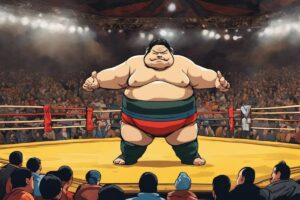Games are an intrinsic aspect of every culture across the planet. Leisure time at home and with friends and family playing games like Monopoly or Chess, is something with which we are all familiar.
From east to west, games have been designed, built, transferred, and reinvented time and again, throughout different cultures and across time.

Japanese games are no exception to this. There are a number of games which are considered, by the Japanese, as ‘traditional’ to their own country.
Games which are not technically Japanese but that have been adopted, adapted and advances; now rooted within its history.
What to Expect – From Gomoku (Go) to Mahjong, this article will explore the main five and introduce you to the exciting and familiar world of traditional Japanese tabletop games.
1 – Gomoku – 五目並べ (c.850)
The most rooted game in Japanese history, this tabletop board game reaches far back into the early years of Japanese culture as we know it today.
Based in both arithmetic and strategy, it is also known as ‘Five in a Row’ or abbreviated as ‘Go’ (which means ‘5’).
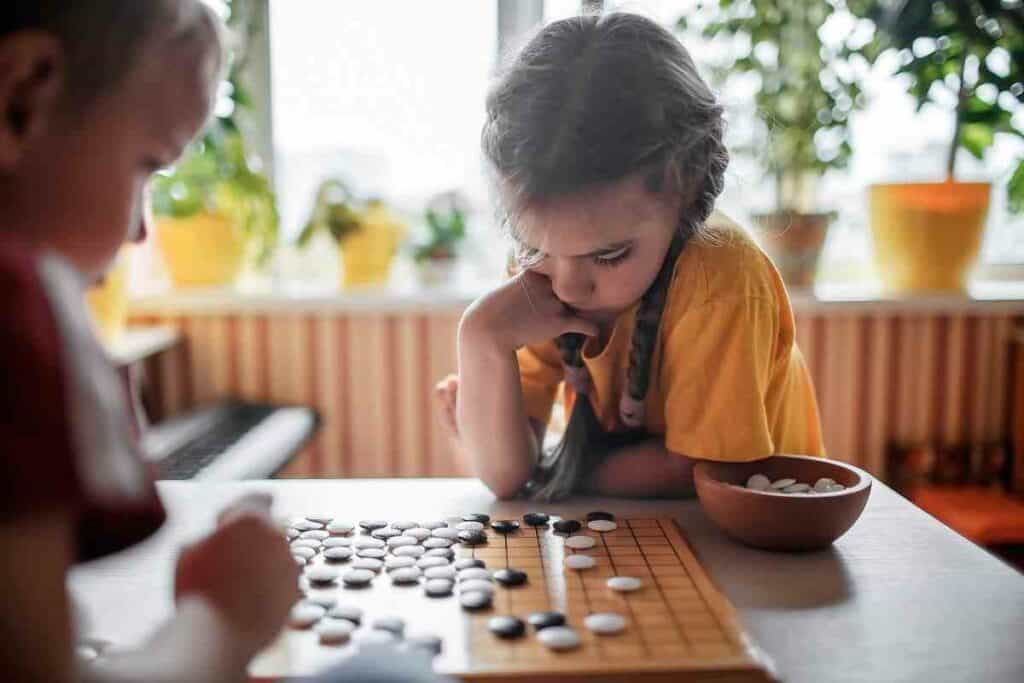
This game consists of a ‘Go board’ of small squares (15×15) and little black and white ‘Go pieces’, made from painted stones.
It was once even considered to be staple equipment for the Samurai way back in the 16th century.
Also popular in other parts of Asia, Gomoku boards come in all kinds of variations, from green, plastic boards, to more traditionally handmade, wooden ones.
Like many other games, it has evolved and there are even online versions and mobile phone apps available.
Keeping it simple, however, you can easily use a pen and a piece of paper, should you wish to do so.
What does a traditional Japanese Gomoku board look like?
There is a specific style of board the Japanese make that is considered to be traditional in the culture.
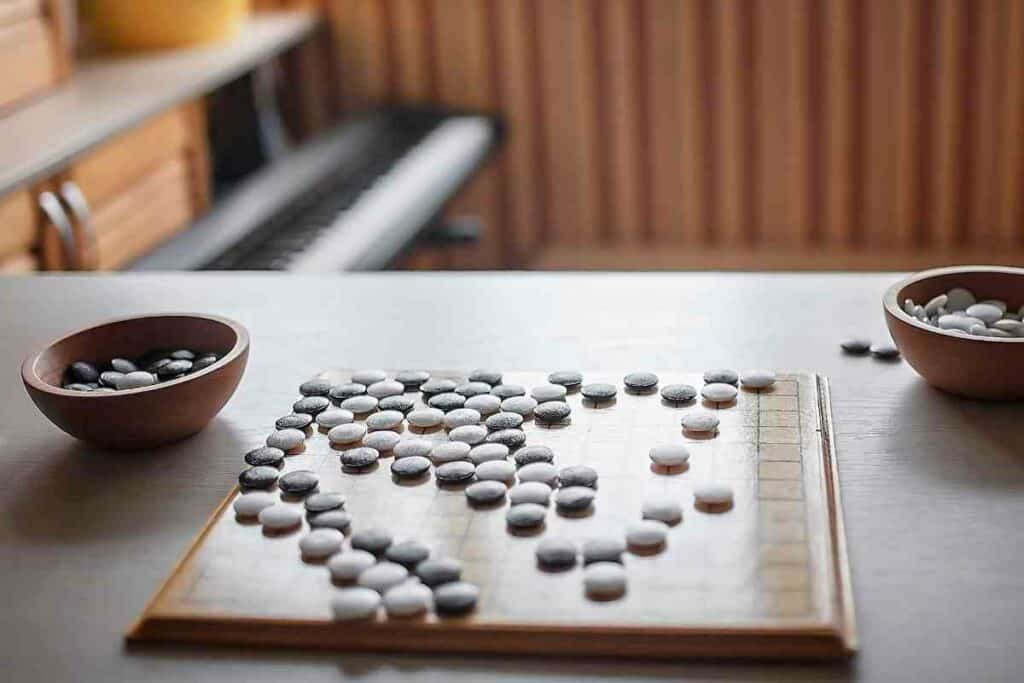
Made from a thick, solid block of wood, it is crafted along with four removable legs/feet and the whole board is coloured yellow.
Some of the underside of the board is often whittled out in order to make it slightly hollow.
This not only makes it a lighter board to carry but it also creates a distinct tap sound when each piece is placed onto the board.
Similar to a string instrument, some traditionally made boards will even have strings attached beneath and when the pieces are played, notes are sounded.
How do you play Gomoku?
Advantage lies within the first move made, much like Tic Tac Toe (Noughts and Crosses in some parts of the world).
Black moves first and the aim of the game is to place 5 stones in an uninterrupted line, before your opponent, taking turns.
It reminds you of games like ‘Connect 4’. Your opponent then has to use their pieces in order to block and interrupt lines whilst trying to link their own five.
In official, championship games rules can get pretty mathematical as they formed a strategy known as Swap2 which almost completely removed the player one advantage (Renju).
However, traditional rules like placing the first piece at the centre of the board, don’t really apply in freestyle versions of the game.
2 – Renju – 連珠 (c.1899)
Considered to be the official variation of Gomoku, Renju is a newer game which was developed from it and is one in which the rules have been changed in order to take away the traditional first player advantage and make it more suitable for competition.
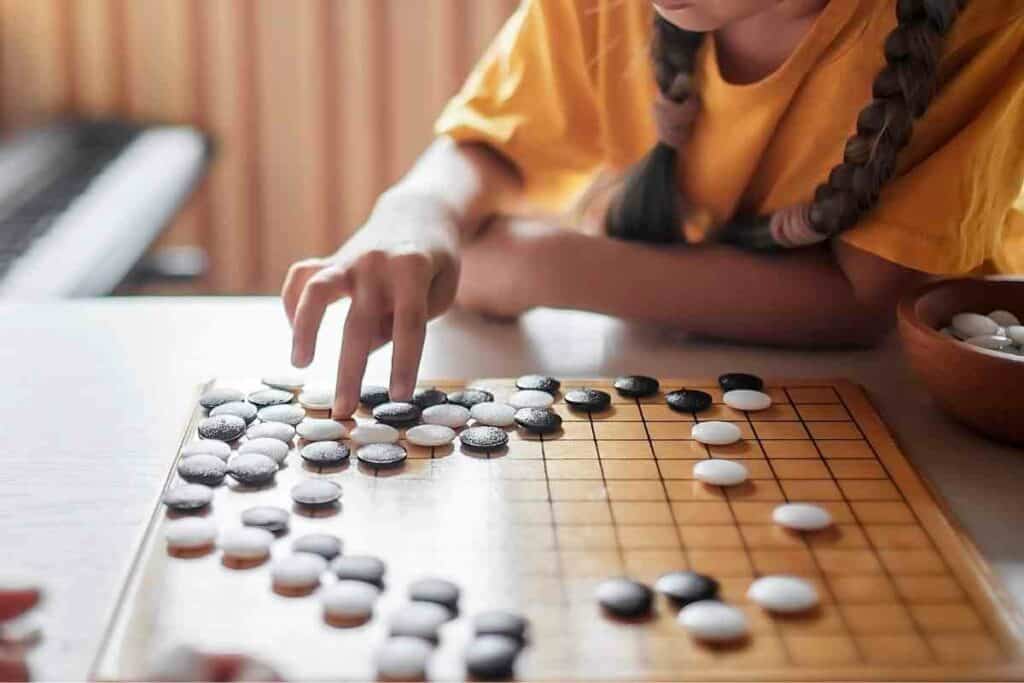
In Japanese, the word ‘Renju’ itself, means ‘connected pearls’ and is different from Gomoku because of its multiple adaptations.
These include variations of the opening move, referred to as ‘swaps’, as well as forbidden moves and an additional winning strategy of pushing Black into making a foul move.
3 – Riichi Mahjong -リーチ麻雀 (1924)
Many aspects of Japanese culture are founded within China.
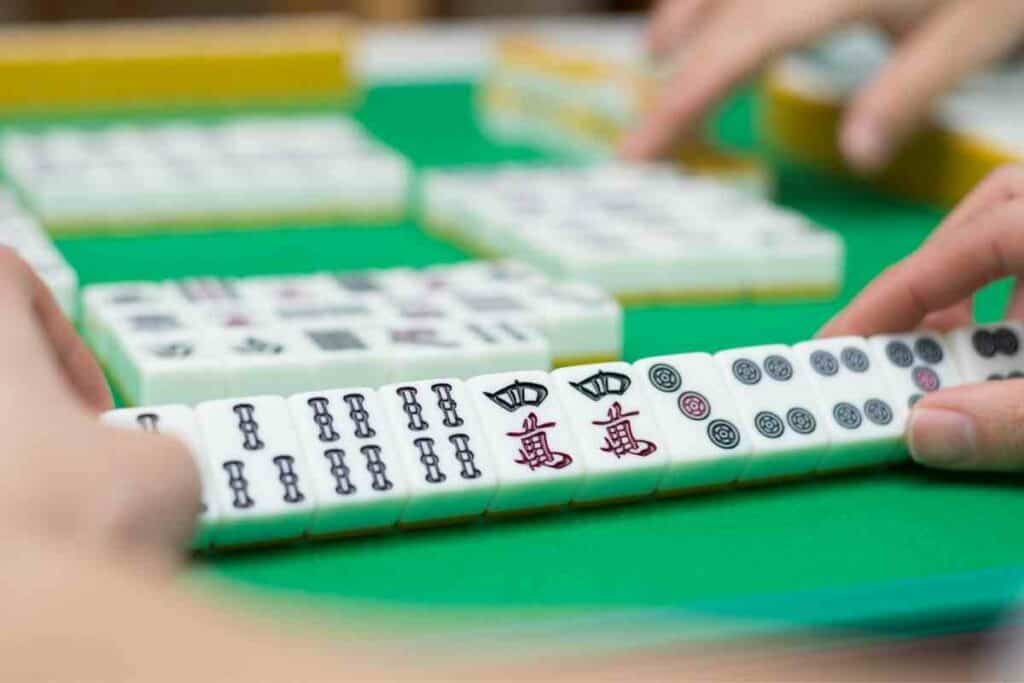
Riichi Mahjong is no exception to this, being the Japanese rendition of the traditional Chinese game: Mahjong.
With a level of complexity rivalling that of Poker, it can be a challenge to learn for a beginner.
However, as with many such games, it is quite enough to learn the basics and add to your gaming knowledge along the way.
A game for up to 4 players, there are a great many details to remember.
Riichi Mahjong Tiles
The game is made up of 136 tiles (divided into) 4 different sets of 34 (and) consisting of 3 suits:
- Manzu – abbreviated and referred to as ‘Man’ and consists of both ‘Characters’ and ‘Cracks’. Numeric symbols 1-9 are present in both Chinese and Japanese script.
- Pinzu – shortened and otherwise named ‘Pin’, this set presents numbers 1-9 in Circles with Dots.
- Souzu – also known as ‘Sou’, for short, these tiles are illustrated with 1-9 in Bamboo and Sticks. Number 1 tile is often represented with the symbol of a single bird: usually a peacock.
There are also two subcategories known as honour/value tiles:
- Winds: North, East, South & West
- Dragons: Red, White & Green
This Japanese version negates the Joker tiles which are in the American version, as well as tiles for the seasons and flowers which are often found in the Chinese game.
In Japan: The game can also be used with the number 5 tile in each of the suits replaced with a red one.
How do you play Riichi Mahjong?
With some patience, to begin with.
Very much like Poker, the aim of this game is to put tiles together to form a winning combination known as a ‘hand’.
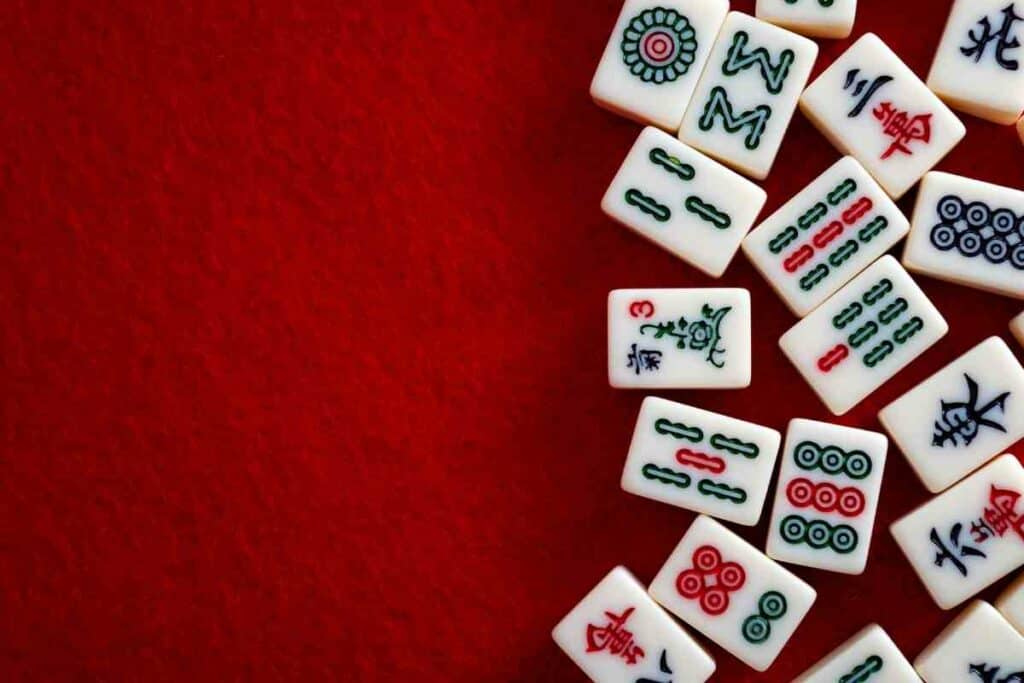
A hand is a combination of similar sets. Your hand must supersede that of all of your opponents. Some hands are obviously better than others.
Learning at least these different hands, and gaining some familiarity with the tiles, should get you started.
The Hand
Each player is dealt a total of 13 tiles.
The remainder of the tiles are used to form the ‘Wall’, from which players take a tile or a discarded one from another player.
After each turn, if you have a full hand then you can declare a possible win.
If not, then you must discard a tile and the play goes on:
- A Sequence – Shuntsu: The simplest type of hand, Shuntsu sequences are comprised of sets of 3 from the same suit. Your hand can’t contain tiles from the ends of suits (1s or 9s), other suits or honour tiles.
- A Triplet – Koutsu: Three identical tiles together.
- A Kan – Kantsu: Unlike other hands, a Kan consists of 4 tiles and not 3. It needs to be declared in order to claim an additional tile from the wall and make the full hand. A full Kan is illustrated by showing the hand but flipping a single tile at each end. This is called a ‘closed Kan’ and does not need to be called immediately but obviously must be before the player can win.
What is Yaku?
A key difference between this and Chinese Mahjong is the presence of what is referred to a ‘yaku’.
Something that is unique about the hand which adds value to it. This makes the game much more complex and harder to win.
While there are many more details, this game is one in with which you can have lots of fun.
4 – Shogi – 将 棋 (c.16th C)
Basically, Japanese Chess; Shogi is rumoured to have originated in India back in the 1700s: a game called ‘Chaturanga’.
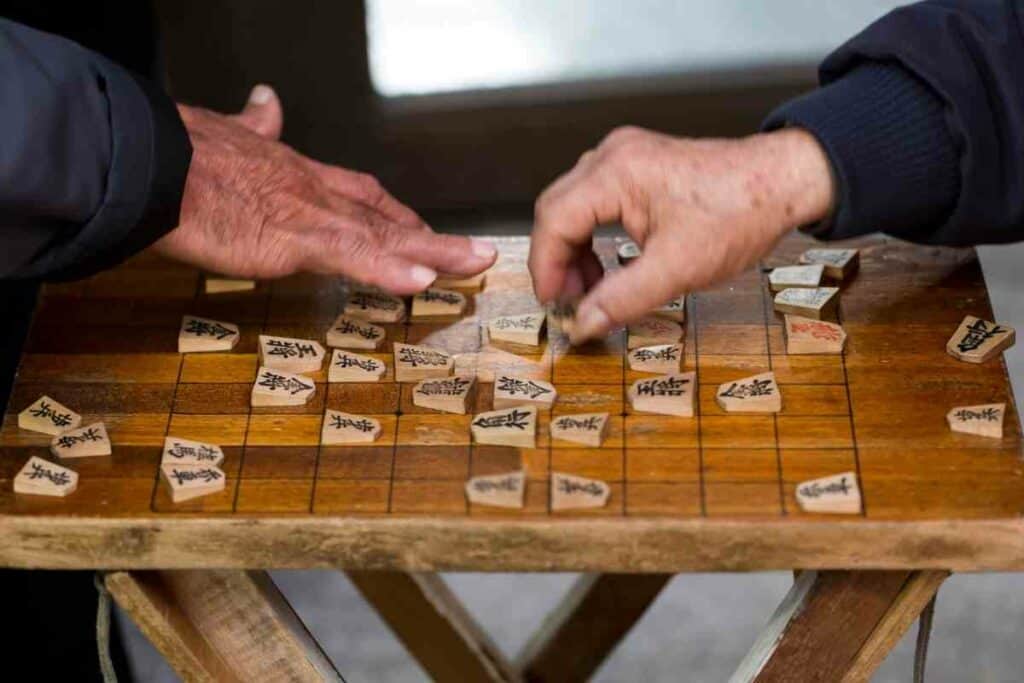
Many variations of Chess exist but Shogi is said to have been the rendition which introduced the rule allowing pieces that have been captured to return to the game.
It seems that the Japanese literally advance each game they adopt by creating mathematically sound rules which make gameplay more complex.
Shogi Equipment
Similarly, to other variations, the board is often made from wood and is sectioned into squares: 9×9, equalling 81 squares.
Players are referred to as:
- the first player (Sente – 先手)
- and the second player (Gote – 後手)
Player promotion lines are marked by two pairs of dots situated on the connecting lines between squares – creating a centre 3×3 square area on the board.
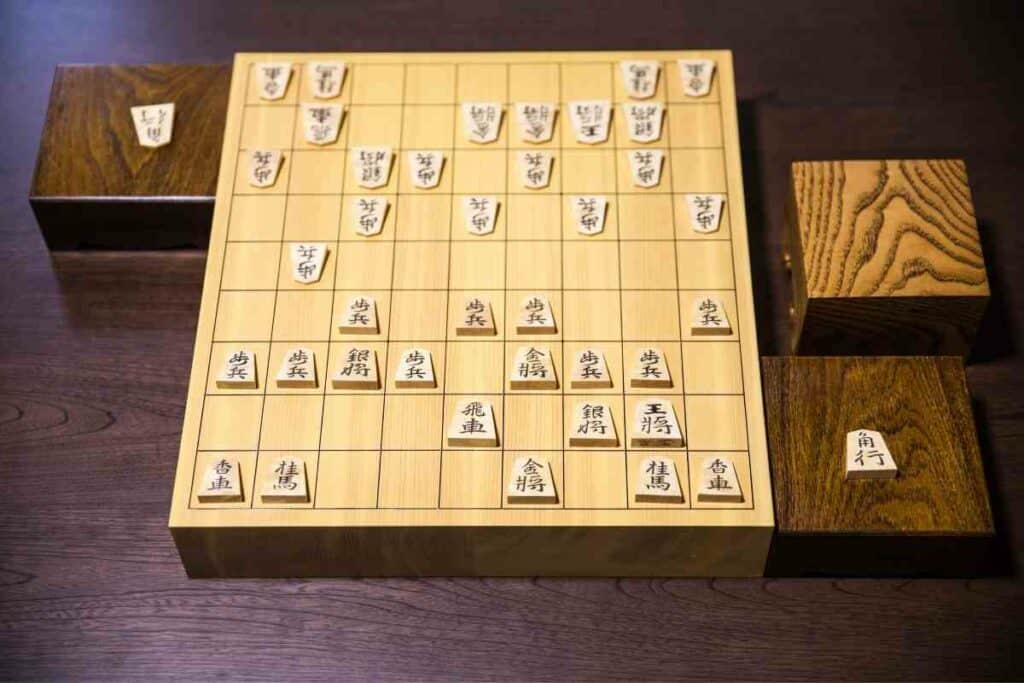
The game’s 40 pieces are usually flat pentagons; split evenly – 20 for each player.
Each is two-sided, with one usually in black inked Kanji symbols and the other in red, to demonstrate promotion.
Many are unique to Shogi but have some obvious correlations with other variations:
- 9 Pawns
- 2 Knights
- 2 Gold Generals
- 2 Silver Generals
- 2 Lances
- 1 Bishop
- 1 Rook
- 1 King
How do you play Shogi?
The aim of the game is exactly the same in most variations: Checkmate – forcing the opposing King into a square from which it is unable to make further moves.
There are other ways for it to end, as in a draw or in official competitions there are also impasses, repetitions, and illegal moves.
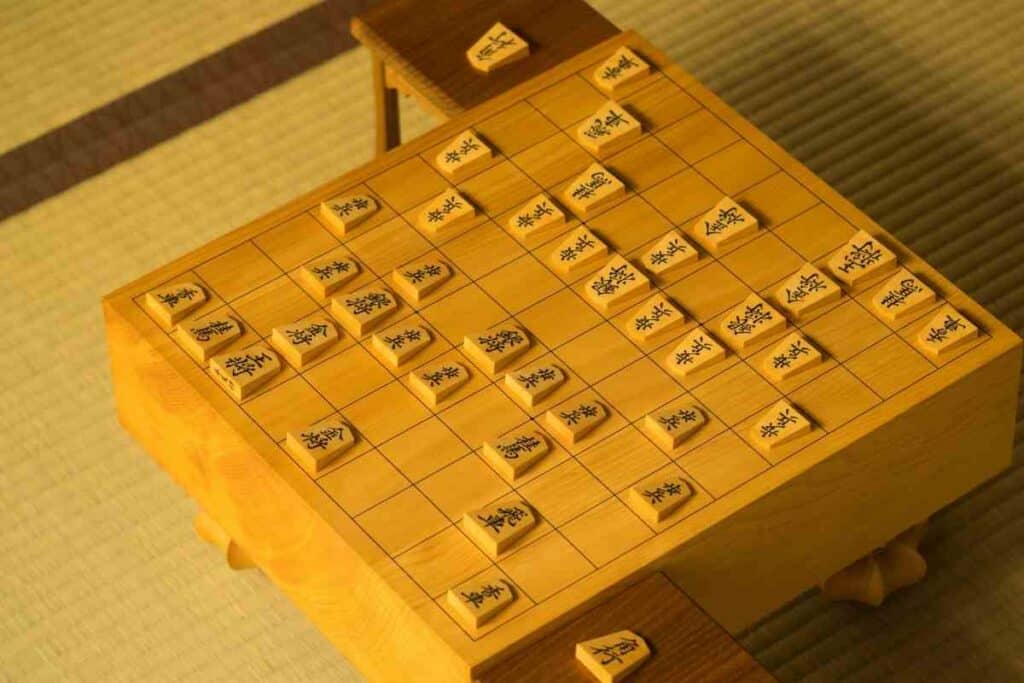
Pieces also have many other similarities than simply names:
- Ranging Pieces: Rook, Lance & Bishop, all have no limits to the squares they can move along a single path. Rook only moves orthogonally and the Bishop, diagonally. The Lance, however, can only move forwards. If any of them encounter an opposing piece, it is then captured.
- Pawns – can move one square forward, not unlike Chess, but they cannot move diagonally and capture opposing pieces in the same direction.
- Knight – again, as with the international Chess piece, this is the only one which can be used to hop over another piece. However, the difference here is that it cannot move to the sides…only in a forward direction, two squares. One square forward and another diagonally forward.
- Gold General – can only move one square orthogonally or diagonally forward.
- Silver General – can only move a single square in any diagonal direction or one forward.
As you can see, there are some very unique aspects of Shogi, and each piece can also be promoted when it passes a player’s promotion lines.
Pawns, like the Silver General, the Knight and Lance all become Gold Generals.
Bishops and rooks have the power of a king added. Kings and gold generals cannot be promoted.
There many, many intricate rules to this game and, as with Riichi Mahjong, you are best learning the basics and then the rest as you go.
5 – Sugoroku – 双六 (6th C)
This traditional Japanese game would be known as ‘Double Six’ in English.
Described, in many ways like a Japanese Monopoly-style, dice rolling board game, it has been created in themes, like popular anime versions; it has been designed around historical events, Religion, Politics, Fiction and popular movies (even adult themes exist).
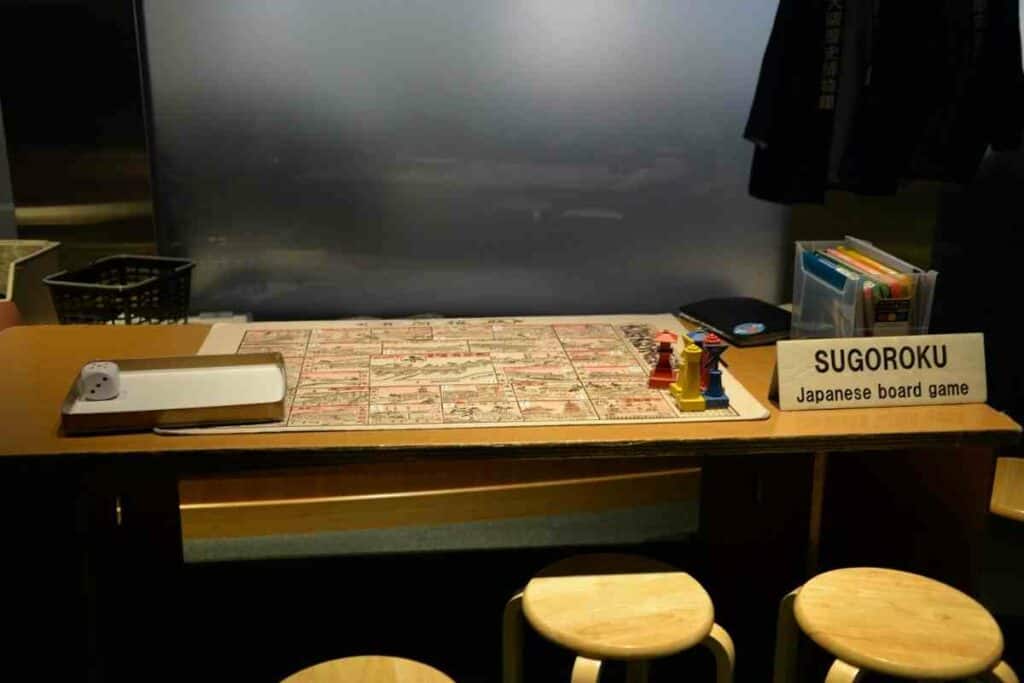
Its origins lie in the 12th century, but the most common version is actually from around the 17th, which is the more illustrated adaptation of the two types.
This is known as ‘e-sugoroku’ in which the ‘e’ stands for ‘image’ and is a simpler version of the game.
Ban-sugoroku is a little more complex and said to be more like western Backgammon.
How do you play e-sugoroku?
Aligned with the type of gameplay that is familiar in Snakes & Ladders, the dice are rolled, and the combined total is the number of spaces to move.
First to the end wins!
Based on Luck – It was most popular among adults but now is much more juvenile; a popular and traditional game for the kids on Japanese New Year’s Day.
How do you play ban-sugoroku?
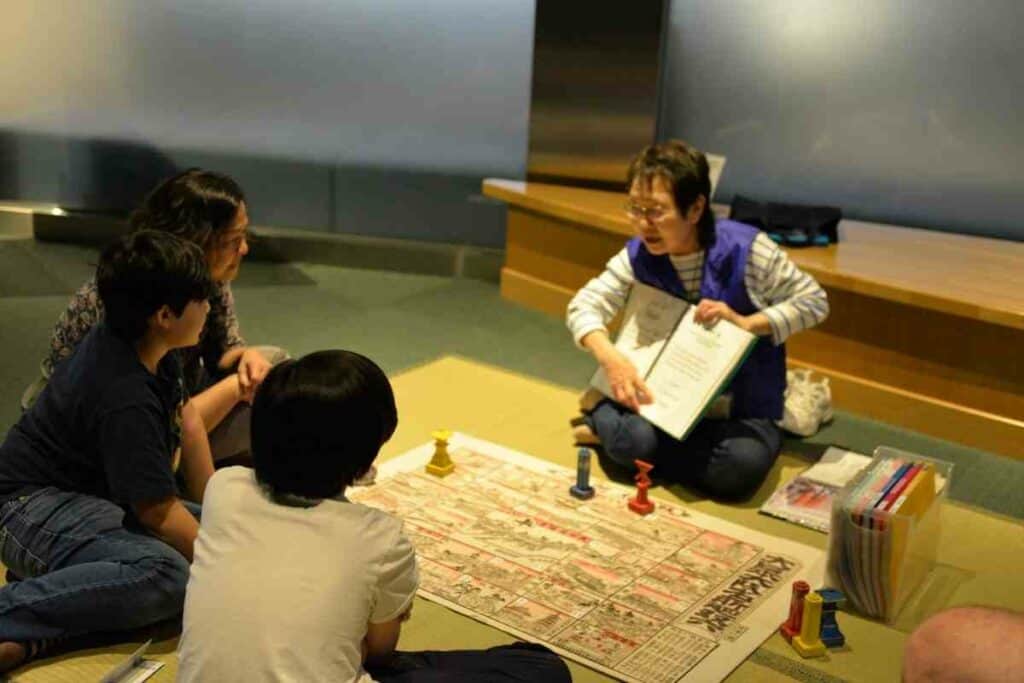
With a similar starting point to Backgammon, there are a few different rules to follow.
Rolling a double doesn’t mean anything extra.
You can win automatically with a move known as ‘closing out’: linking 6 adjacent points (known as a prime) but one or more of your opponent’s men must be present on the central bar.
There is also no doubling cube.
Final Thoughts
It seems to be the case that there are no “Japanese” games, as such.
Traditional games are all adaptations of imported games from other cultures around the world yet, with obvious exceptions, the Japanese versions all appear to be much more sophisticated, following their adaptations.
Japanese games are much more intricate and generally more complex.
As with similar western games, these traditional, Japanese tabletop games have stood the test of time and are still very popular to this day.
Read Next
- The Forbidden Japanese Island That Will Give You Nightmares
- Miss Japan Forced to Wear Sailor Moon Costume Since Childhood: Claims It’s the Secret to Her Success
- Essential Guide to Japan VPN: Secure Access and Privacy for Travelers
- Sumo Wrestler Suit for Adults by TOLOCO: Best Sumo Suit?
- Eki Stamp Book (Gotta Collect Them All!)
- Explore the Fascinating World of Japanese Rubik’s Cubes




